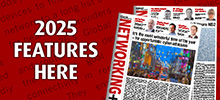06 June 2024

Duncan Swan, chief operating officer, British APCO
Critical Communications World (CCW) was back for it’s 25th anniversary in May returning to Dubai and a chance to see how east meets west on the exhibition floor and in the conference rooms.
The move towards using commercial mobile networks to deliver broadband critical communications is primarily based upon this being the most affordable way for most countries to deliver 4G and 5G based solutions. However, in Dubai it is a little different – with Nedaa, the Dubai Government secure networks provider, enhancing their mission critical TETRA radio network with a self-built 4G LTE network that offers 3GPP MCX broadband functionality for the Emirate amongst other Safe and Smart City applications. Their network supports both government and private clients – but specifically supporting key aspects of public safety and security.
“The move towards using commercial mobile networks to deliver broadband critical communications is primarily based upon this being the most affordable way for most countries to deliver 4G and 5G based solutions.”
Listening to representatives of Nedaa was a bright spot in terms of mission critical mobile network use cases – around Europe and North America in particular much is said to be happening but getting real nuggets or soundbites as to tangible delivery progress was as difficult as actually delivering these incredibly complex programmes of work – be that technically, financially, or from an end-user change perspective.
Technically complex to build and deliver, LTE based mission critical solutions still face questions around their underpinning design philosophy. New to CCW2024 were a series of focus group discussions, opportunities for experts and interested parties to debate specific topics. Supporting communications for large user groups at, say, a major incident remains a topic that polarises discussion – mobile networks tend in the main to be unicast, supporting one-to-one communication. Multicast on the other hand was designed to deliver streaming services but provides the ideal one-to-many communication platform; a possible key to unlock the unicast limitations for very large groups. But it has cost implications to build and deliver – and there are use cases where unicast would be a preference. It’s fair to say discussion on the topic is polarised and undoubtedly some blend of technology will emerge.
As building the LTE mission critical solutions continues, exciting developments were announced on the exhibition floor by several major players in relation to user devices. Sepura launched their SCL3 hand portable that can be deployed as a hybrid TETRA and 4G/5G device, enabling a pathway for the migration to LTE based mission critical communications. And with a launch customer – the UK Ambulance Radio Programme – in place, then we will soon be seeing the SCL3 in action. It certainly represents the best of British with a well thought through form factor; is incredibly lightweight; and, importantly, uses many existing accessories to ease both implementation and the cost burden.
Motorola Solutions were also making a splash with their new MXP660 multi-bearer hand portable TETRA radio which has built-in LTE and Wi-Fi allowing automatic switching to broadband thus staying connected when out of TETRA network coverage (e.g. when deep inside buildings or in heavily built-up areas). Also with a launch customer in mind, SINE (the Danish public safety TETRA network) will be among the first networks deployed that can support the MXP660. Whilst AI has been a key topic at most critical communication conferences this year, and to a degree at CCW 2024, it was fascinating to learn more about the MXP660’s AI-trained background noise suppression capability.
Satellite communications are already playing an important role in critical communication networks, even though there remain challenges to overcome; security, throughput, and latency topping the list. At CCW 2024 we saw the unveiling of a Rapid Deployment Solution by Rohill that integrates Starlink satellite connections with land-based networks. The product is a response to the need for rapid deployment of trusted communication networks during major incidents and large-scale events – but underpins the essential need to support multi-bearer communication to ensure mission critical solutions are robust.
“The 3GPP standards body has specified capabilities of relevance to mission critical communications in the 4G and 5G standards; and it was never going to be long before talking started in earnest around 6G.”

The 3GPP standards body has specified capabilities of relevance to mission critical communications in the 4G and 5G standards; and it was never going to be long before talking started in earnest around 6G. So, no surprise to find a couple of sessions at CCW 2024 on the 6G standard and its relationship with critical communications. Whilst society and the economies of pretty much every country have become hugely dependent on mobile communications supporting such as e-commerce, government, safety and security, 6G should introduce new capabilities that leverage the current ecosystem with seamless integration with 4G and 5G networks. The TCCA believe strongly that 6G should enhance the level of trust users have with systems supporting mission and safety critical operations – and that the 6G standard should simplify the introduction of solutions for critical communications.
A final highlight from CCW 2024 was recognition at the International Critical Communications Awards of the ongoing work between Alea, Softil and Qualcomm to deliver a solution for off-network LTE communications. First announced at the end of 2023, Softil, together with Alea, demonstrated the first ever interoperable direct mode communication using devices powered by Qualcomm 5G-Sidelink technology. With devices able to discover each other and communicate without network connectivity then a key critical communications user requirement looks to be finally on the path to resolution. This could be a real game changer for user organisations not only during transition to mobile broadband networks from traditional mobile radio networks but also in areas where it is simply not possible to provide mobile network coverage (or when base sites are down).
Delivering critical communications remains a vibrant industry sector; Critical Communications World returns to Europe in June 2025, and will be hosted in Brussels. At the home of the European Union, it will be interesting to see if the BroadEU.net initiative is showcased alongside the host nations Astrid Network, and all that it can offer. BroadEU.net is a European Union initiative working to develop a pan-European mobile broadband system that interconnects each participating Nations’ 4G/5G MCX critical communications network – essentially a virtual pan-European network for all first responders, emergency, and security agencies.








.jpg?lu=248)

